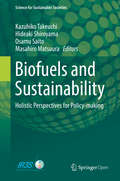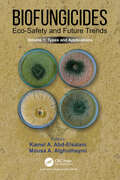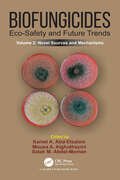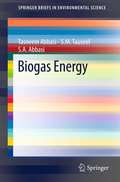- Table View
- List View
Biofuels, Air Pollution, and Health: A Global Review (pdf) (Modern Perspectives in Energy)
by Kirk R. SmithBiofuels and Biodiesel (Methods in Molecular Biology #2290)
by Chhandak BasuThis volume provides methods and protocols on principle, production, molecular aspects, and sustainability of biofuel and biodiesel. Chapters are divided into four sections detailing biofuel production, biodiesel production, molecular genetics, biotechnology of biofuel and biodiesel production, economics, and sustainability of biofuel production. Written in the highly successful Methods in Molecular Biology series format, chapters include introductions to their respective topics, lists of the necessary materials and reagents, step-by-step, readily reproducible laboratory protocols, and tips on troubleshooting and avoiding known pitfalls. Authoritative and cutting-edge, Biofuels and Biodiesel aims to be useful for researchers, students, and enthusiasts in the field of biofuel and biodiesel.
Biofuels and Bioenergy
by John Love John A. BryantWith increased public and scientific attention driven by factors such as oil price spikes, the need for increased energy security, and concerns over greenhouse gas emissions from fossil fuels, the production of fuels by biological systems is becoming increasingly important as the world seeks to move towards renewable, sustainable energy sources. Biofuels and Bioenergy presents a broad, wide-ranging and informative treatment of biofuels. The book covers historical, economic, industrial, sociological and ecological/environmental perspectives as well as dealing with all the major scientific issues associated with this important topic.With contributions from a range of leading experts covering key aspects, including: • Conventional biofuels.• Basic biology, biochemistry and chemistry of different types and classes of biofuel.• Current research in synthetic biology and GM in the development and exploitation of new biofuel sources.• Aspects relating to ecology and land use, including the fuel v food dilemma.• Sustainability of different types of biofuel.• Ethical aspects of biofuel production. Biofuels and Bioenergy provides students and researchers in biology, chemistry, biochemistry and chemical engineering with an accessible review of this increasingly important subject.
Biofuels and Bioenergy
by John Love John A. BryantWith increased public and scientific attention driven by factors such as oil price spikes, the need for increased energy security, and concerns over greenhouse gas emissions from fossil fuels, the production of fuels by biological systems is becoming increasingly important as the world seeks to move towards renewable, sustainable energy sources. Biofuels and Bioenergy presents a broad, wide-ranging and informative treatment of biofuels. The book covers historical, economic, industrial, sociological and ecological/environmental perspectives as well as dealing with all the major scientific issues associated with this important topic.With contributions from a range of leading experts covering key aspects, including: • Conventional biofuels.• Basic biology, biochemistry and chemistry of different types and classes of biofuel.• Current research in synthetic biology and GM in the development and exploitation of new biofuel sources.• Aspects relating to ecology and land use, including the fuel v food dilemma.• Sustainability of different types of biofuel.• Ethical aspects of biofuel production. Biofuels and Bioenergy provides students and researchers in biology, chemistry, biochemistry and chemical engineering with an accessible review of this increasingly important subject.
Biofuels and Bioenergy: International Conference, Bhopal, India, 23-25 February 2016 (Springer Proceedings in Energy)
by S. Suresh Anil Kumar Ashish Shukla Renu Singh C. M. KrishnaThese conference proceedings provide a comprehensive overview of and in-depth technical information on all possible bioenergy resources (solid, liquid, and gaseous), including cutting-edge themes such as advanced fuels and biogas. The book includes current state-of-the-art topics ranging from feedstocks and cost-effective conversion processes to biofuels economic analysis and environmental policy, and features case studies and quizzes for each section derived from the implementation of actual hands-on biofuel projects to aid learning. It offers readers a starting point on this challenging and exciting path. The central concepts are defined and explained in the context of process applications under various topics. By focussing on the pertinent fundamental principles in the environment and energy sciences and by repeatedly emphasizing the importance of their correlation, it offers a strong foundation for future study and practice. Learning about fundamental properties and mechanisms on an ongoing basis is absolutely essential for long-term professional viability in a technically vibrant area such as nanotechnology. The book has been written for undergraduate and graduate students in chemical, energy and environment engineering. However, selected sections can provide the basis for courses in civil, mechanical or electrical engineering. It includes a self-contained presentation of the key concepts of energy resources, solar thermal and photovoltaic systems, nuclear energy, biomass conversion technology and agricultural-waste processing. Throughout it interweaves descriptive material on sustainable development, clean coal technology, green technology, solid-waste management and lifecycle assessments. It offers an introduction to these topics rather than comprehensive coverage of the themes and their in-depth fundamentals.
Biofuels and Sustainability: Holistic Perspectives for Policy-making (Science for Sustainable Societies)
by Hideaki Shiroyama Osamu Saito Kazuhiko Takeuchi Masahiro MatsuuraThis open access book presents a comprehensive analysis of biofuel use strategies from an interdisciplinary perspective using sustainability science. This interdisciplinary perspective (social science-natural science) means that the strategies and policy options proposed will have significant impacts on the economy and society alike. Biofuels are expected to contribute to reducing greenhouse gas emissions, revitalizing economies in agricultural communities and alleviating poverty. However, despite these anticipated benefits, international organizations such as the FAO, OECD and UN have published reports expressing concerns that biofuel promotion may lead to deforestation, water pollution and water shortages. The impacts of biofuel use are extensive, cross-sectoral and complex, and as such, comprehensive analyses are required in order to assess the extent to which biofuels can contribute to sustainable societies. Applying interdisciplinary sustainability science concepts and methodologies, the book helps to enhance the establishment of a sustainable society as well as the development of appropriate responses to a global need for urgent action on current issues related to biofuels.
Biofuels from Algae: Methods and Protocols (Methods in Molecular Biology #1980)
by Kristian SpillingThis volume provides a comprehensive overview of different ways to grow algae and the techniques used to start algal cultivation, monitor algal growth, environmental impact of growing algae, and various methods for characterizing the biomass. The chapters in this book discuss a range of topics such as step-by-step protocols on how to isolate and grow algae; descriptions on how to use fluorescence to estimate algal biomass and lipid content; and instructions on using advanced techniques to determine the carbohydrates and lipids in algal biomass. Written in the highly successful Methods in Molecular Biology series format, chapters include introductions to their respective topics, lists of the necessary materials and reagents, step-by-step, readily reproducible laboratory protocols, and tips on troubleshooting and avoiding known pitfalls.Authoritative and cutting-edge, Biofuels from Algae: Methods and Protocols is a valuable resource for novice and experienced researchers who want to learn more about this impactful and developing field.
Biofuels from Food Waste: Applications of Saccharification using Fungal Solid State Fermentation
by Antoine Prandota TrzcinskiAccording to the UN's Food & Agricultural Organization (FAO), one third of food produced globally for human consumption (nearly 1.3 billion tons) is lost annually. Food waste has often been incinerated with other combustible municipal wastes for possible recovery of heat or other forms of energy, however, incineration is not cost-effective, and can cause air pollution. Due to its organics- and nutrient-rich nature, food waste could be viewed as a useful resource for production of high-value platform chemicals through fermentation. This book examines the bioconversion of food wastes to energy and the recent developments in ethanol, hydrogen, methane, and biodiesel production from food wastes.
Biofuels from Food Waste: Applications of Saccharification using Fungal Solid State Fermentation
by Antoine Prandota TrzcinskiAccording to the UN's Food & Agricultural Organization (FAO), one third of food produced globally for human consumption (nearly 1.3 billion tons) is lost annually. Food waste has often been incinerated with other combustible municipal wastes for possible recovery of heat or other forms of energy, however, incineration is not cost-effective, and can cause air pollution. Due to its organics- and nutrient-rich nature, food waste could be viewed as a useful resource for production of high-value platform chemicals through fermentation. This book examines the bioconversion of food wastes to energy and the recent developments in ethanol, hydrogen, methane, and biodiesel production from food wastes.
Biofuels in Brazil: Fundamental Aspects, Recent Developments, and Future Perspectives
by Silvio Silvério Silva Anuj Kumar ChandelThis book discusses the commercialization of biofuels and the Brazilian government policies for the promotion of renewable energy program in Brazil, which could be a learning module for several countries for implementing biofuels policy to improve their socioeconomic status and make them energy independent.Researchers in academia and industries, policy makers, and economic analysts will be assisted by important source of information in their ongoing research and future perspectives.This book will benefit graduate and postgraduate students of chemical and biochemical engineering, forestry, microbiology, biochemistry, biotechnology, applied chemistry, environmental science, sustainable energy, and biotech business disciplines by signifying the applied aspects of bioenergy production from various natural sources and their implications. Graduate and postgraduate students as well as postdoctoral researchers will find clear concepts of feedstock analysis, feedstock degradation, microbial fermentation, genetic engineering, renewable energy generation and storage, climate changes, and techno-economic analysis of biofuels production technologies.
Biofuels Production – Sustainability and Advances in Microbial Bioresources (Biofuel and Biorefinery Technologies #11)
by Rajeeva Gaur Ajar Nath Yadav Ali Asghar Rastegari Neelam YadavThis book focuses on the different kinds of biofuels and biofuel resources. Biofuels represent a major type of renewable energy. As part of a larger bio-economy, they are closely linked to agriculture, forestry and manufacturing. Biofuels have the potential to improve regional energy access, reduce dependence on fossil fuels and contribute to climate protection. Further, this alternative form of energy could revitalize the forestry and agricultural sector and promote the increased use of renewable resources as raw materials in a range of industrial processes. Efforts are continuously being made to develop economically competitive biofuels, and microbes play important roles in the production of biofuels from various bioresources. This book elaborates on recent advances in existing microbial technologies and on sustainable approaches to improving biofuel production processes. Additionally, it examines trends in, and the limitations of, existing processes and technologies. The book offers a comprehensive overview of microbial bioresources, microbial technologies, advances in bioconversion and biorefineries, as well as microbial and metabolic engineering for efficient biofuel production. Readers will also learn about the environmental impacts and the influence of climate change on the sustainability of biofuel production. This book is intended for researchers and students whose work involves biorefinery technologies, microbiology, biotechnology, agriculture, environmental biology and related fields.
Biofuels Production and Processing Technology (Fuels and Petrochemicals)
by M. R. Riazi David ChiaramontiThe importance of biofuels in greening the transport sector in the future is unquestionable, given the limited available fossil energy resources, the environmental issues associated to the utilization of fossil fuels, and the increasing attention to security of supply. This comprehensive reference presents the latest technology in all aspects of biofuels production, processing, properties, raw materials, and related economic and environmental aspects. Presenting the application of methods and technology with minimum math and theory, it compiles a wide range of topics not usually covered in one single book. It discusses development of new catalysts, reactors, controllers, simulators, online analyzers, and waste minimization as well as design and operational aspects of processing units and financial and economic aspects. The book rounds out by describing properties, specifications, and quality of various biofuel products and new advances and trends towards future technology.
Biofuels Production and Processing Technology (Fuels and Petrochemicals)
by M. R. Riazi David ChiaramontiThe importance of biofuels in greening the transport sector in the future is unquestionable, given the limited available fossil energy resources, the environmental issues associated to the utilization of fossil fuels, and the increasing attention to security of supply. This comprehensive reference presents the latest technology in all aspects of biofuels production, processing, properties, raw materials, and related economic and environmental aspects. Presenting the application of methods and technology with minimum math and theory, it compiles a wide range of topics not usually covered in one single book. It discusses development of new catalysts, reactors, controllers, simulators, online analyzers, and waste minimization as well as design and operational aspects of processing units and financial and economic aspects. The book rounds out by describing properties, specifications, and quality of various biofuel products and new advances and trends towards future technology.
Biofuels, Solar and Wind as Renewable Energy Systems: Benefits and Risks
by D. PimentelThe petroleum age began about 150 years ago. Easily available energy has s- ported major advances in agriculture, industry, transportation, and indeed many diverse activities valued by humans. Now world petroleum and natural gas s- plies have peaked and their supplies will slowly decline over the next 40–50 years until depleted. Although small amounts of petroleum and natural gas will remain underground, it will be energetically and economically impossible to extract. In the United States, coal supplies could be available for as long as 40–50 years, depending on how rapidly coal is utilized as a replacement for petroleum and natural gas. Having been comfortable with the security provided by fossil energy, especially petroleum and natural gas, we appear to be slow to recognize the energy crisis in the U. S. and world. Serious energy conservation and research on viable renewable - ergy technologies are needed. Several renewable energy technologies already exist, but sound research is needed to improve their effectiveness and economics. Most of the renewable energy technologies are in uenced by geographic location and face problems of intermittent energy supply and storage. Most renewable technologies require extensive land; a few researchers have even suggested that one-half of all land biomass could be harvested in order to supply the U. S. with 30% of its liquid fuel! Some optimistic investigations of renewable energy have failed to recognize that only 0. 1% of the solar energy is captured annually in the U. S.
Biofunctional Membranes
by D. A. Butterfield''Interesting with many useful ideas and references. It covers a broad range and it is a good introduction to this field.'' ---Analyst
Biofunctional Surface Engineering
by Martin ScholzSuccessful biofunctional surface engineering will determine the future of medical devices such as orthopedic implants, stents, catheters, vaccine scaffolds, wound dressings, and extracorporeal circulation devices. Moreover, the biosensor and diagnostic chip technology will evolve rapidly due to the growing medical need for personalized medicine. A
Biofunctionalization of Polymers and their Applications (Advances in Biochemical Engineering/Biotechnology #125)
by Gibson Stephen Stephen Nyanhongo, Walter Steiner and Georg M. GübitzChitin, Chitosan and Derivatives for Wound Healing and Tissue Engineering, by Antonio Francesko and Tzanko Tzanov Polyhydroxyalkanoates (PHA) and their Applications, by Guo-Qiang Chen.- Enzymatic Polymer Functionalisation: Advances in Laccase and Peroxidase Derived Lignocellulose Functional Polymers, by Gibson S. Nyanhongo, Tukayi Kudanga, Endry Nugroho Prasetyo and Georg M. Guebitz.- Lipases in Polymer Chemistry, by Bahar Yeniad, Hemantkumar Naik and Andreas Heise.- Enzymes for the Biofunctionalization of Poly(Ethylene Terephthalate), by Wolfgang Zimmermann and Susan Billig.- Biology of Human Hair: Know Your Hair to Control It, by Rita Araújo, Margarida Fernandes, Artur Cavaco-Paulo and Andreia Gomes.- Recombinamers: Combining Molecular Complexity with Diverse Bioactivities for Advanced Biomedical and Biotechnological Applications, by José Carlos Rodríguez-Cabello, María Pierna, Alicia Fernández-Colino, Carmen García-Arévalo and Francisco Javier Arias.- Biomimetic Materials for Medical Application Through Enzymatic Modification, by Piergiorgio Gentile, Valeria Chiono, Chiara Tonda-Turo, Susanna Sartori and Gianluca Ciardelli.- Supramolecular Polymers Based on Cyclodextrins for Drug and Gene Carrier Delivery, by Jia Jing Li, Feng Zhao and Jun Li.- Engineering Liposomes and Nanoparticles for Biological Targeting, by Rasmus I. Jølck, Lise N. Feldborg, Simon Andersen, S. Moein Moghimi and Thomas L. Andresen.-
Biofungicides: Types and Applications, Volume 1
by Kamel A. Abd-Elsalam Mousa A. AlghuthaymiThe current volume focuses on all the major concerns associated with the biofungicides and provides comprehensive knowledge of microbial and phytochemical fungicides, bioformulations, regulation as well as limitation of biofungicides, and their role in disease management in plants. The use of biofungicides as eco-friendly alternative to traditional synthetic fungicides is likely to play a major role in organic farming in the future.
Biofungicides: Types and Applications, Volume 1
by Kamel A. Abd-Elsalam Mousa A. AlghuthaymiThe current volume focuses on all the major concerns associated with the biofungicides and provides comprehensive knowledge of microbial and phytochemical fungicides, bioformulations, regulation as well as limitation of biofungicides, and their role in disease management in plants. The use of biofungicides as eco-friendly alternative to traditional synthetic fungicides is likely to play a major role in organic farming in the future.
Biofungicides: Novel Sources and Mechanisms, Volume 2
by Kamel A. Abd-Elsalam Mousa A. Alghuthaymi Salah M. Abdel-MomenThe current volume focuses on novel sources of biofungicides, primarily providing complete knowledge of microbial and phytochemical fungicides, studying antifungal activity mechanisms as well as their role in disease management in plants, and fungicide bioremediation. The use of biofungicides as eco-friendly alternative to typical synthetic fungicides is projected to play a significant role in organic farming in the future.Key Features: Discovers novel sources of biofungicides Describes the role of biofungicides in the control of plant diseases Studies antifungal activity mechanisms Explores how to survey and select promising biofungicides
Biofungicides: Novel Sources and Mechanisms, Volume 2
The current volume focuses on novel sources of biofungicides, primarily providing complete knowledge of microbial and phytochemical fungicides, studying antifungal activity mechanisms as well as their role in disease management in plants, and fungicide bioremediation. The use of biofungicides as eco-friendly alternative to typical synthetic fungicides is projected to play a significant role in organic farming in the future.Key Features: Discovers novel sources of biofungicides Describes the role of biofungicides in the control of plant diseases Studies antifungal activity mechanisms Explores how to survey and select promising biofungicides
Biogas: Fundamentals, Process, and Operation (Biofuel and Biorefinery Technologies #6)
by Meisam Tabatabaei Hossein GhanavatiThis book presents the state of the art in biogas production using anaerobic digestion technology, with an emphasis on waste utilization/valorization. Offering a comprehensive reference guide to biogas production from different waste streams, it covers various aspects of anaerobic digestion technology from the basics, i.e., microbiological aspects to prominent parameters governing biogas production systems, as well as major principles of their operation, analysis, process control, and troubleshooting. Written and edited by internationally recognized experts in the field of biogas production from both academia and industry, it provides in-depth and cutting-edge information on central developments in the field. In addition, it discusses and reviews major issues affecting biogas production, including the type of feedstock, pretreatment techniques, production systems, design and fabrication of biogas plants, as well as biogas purification and upgrading technologies. ‘Biogas: Fundamentals, Process, and Operation’ also addresses the application of advanced environmental and energy evaluation tools including life cycle assessment (LCA), exergy, techno-economics, and modeling techniques. This book is intended for all researchers, practitioners and students who are interested in the current trends and future prospects of biogas production technologies.
Biogas Combustion Engines for Green Energy Generation (SpringerBriefs in Applied Sciences and Technology)
by Eiji Tomita Nobuyuki Kawahara Ulugbek AzimovThis book deals with the combustion and exhaust emissions of gas engines fueled with green biogas. Biogas is a mixture of gases, primarily consisting of methane and carbon dioxide. Biogas can be produced from raw materials such as agricultural waste, manure, municipal waste, plant material, sewage, food waste, etc. Biogas is considered to be a renewable source of energy. Therefore, it can contribute to the prevention of global warming.The biogas engine is used to co-generate electricity by operating engine and heat from hot exhaust gases. The energy source used very efficiently. Unlike other green energy sources such as wind and solar, biogas is readily available when needed.This book first describes the basics of biogas and its application to internal combustion engines. Next, it describes the engine system and the combustion phenomena in the engine cylinder. Engine technology continues to advance in spark ignition and dual-fuel engines to achieve higher thermal efficiency and lower harmful emissions. Several advanced combustion technologies are introduced to achieve higher thermal efficiency while avoiding knocking.
Biogas Energy (SpringerBriefs in Environmental Science #2)
by Tasneem Abbasi S.M. Tauseef S.A. AbbasiIn recent years, the importance of biogas energy has risen manifold and has become universal. This is due to the realization that biogas capture and utilization has great potential in controlling global warming. By capturing biogas wherever it is formed, we not only tap a source of clean energy, but we also prevent the escape of methane to the atmosphere. Given that methane has 25 times greater global warming potential than CO2, methane capture through biogas energy in this manner can contribute substantially towards global warming control.
Biogas from Waste and Renewable Resources: An Introduction
by Dieter Deublein Angelika SteinhauserThe leading book on the market just got better: With its unique approach covering all aspects of setting up and running a biogas plant, this new edition has been expanded to include recent advances in biomass processing. The author is a key player in the field, who has designed numerous small- and industrial-scale biogas plants, and who is also a long-time lecturer on biogas production, thus combining didactical skill with real-life expertise. As such, he covers both the biological and technical aspects of biogas generation. The full range of biogas substrates and processing modes is explained, from agricultural and industrial waste to marine algae and sediment. On-site use of biogas for conversion into electricity, fuel and heat is also discussed, as are safety and regulatory issues. Many real-life examples of European biogas plants already in operation illustrate the contents, as do numerous schemes, diagrams and summary tables. For this new edition, biogas analytics and quality control required for feeding biogas into natural gas networks are included, as is a completely new chapter on the microbiology of biogas-producing bacterial communities.



















